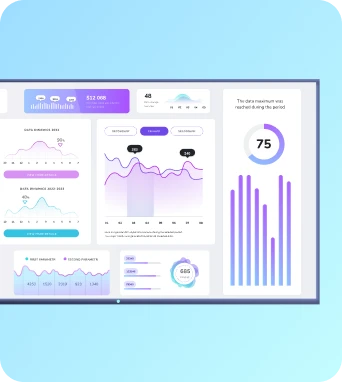AI-powered customer insights
AI-powered customer insights use machine learning and computer vision to analyse audience behaviour at digital signage touchpoints. They turn anonymised viewing data — dwell time, attention, footfall and engagement patterns — into actionable metrics that help operators optimise content, measure campaign ROI and improve in-store experience and signage performance.
AI-powered customer insights
How AI captures and interprets audience behaviour
AI systems deployed for digital signage typically rely on a blend of edge and cloud processing to collect and interpret audience signals. Edge inference on players or cameras means sensitive visual data can be processed locally and converted into anonymised metrics before it ever leaves the device. Machine learning models detect presence, estimate age or gender brackets only where permitted, and measure dwell time and viewing angle. These signals are then aggregated into events such as "impression", "engaged view" or "skipped", providing a continuous stream of behavioural data that feeds into dashboards and reporting tools. For signage network managers and IT teams, the practical value lies in turning these metrics into decisions. AI identifies peak attention periods, highlights underperforming zones and measures the uplift from creative variants. Integrations with point-of-sale systems and Wi-Fi analytics let you map content exposure to sales, footfall or conversion funnels, making it easier to quantify campaign ROI. Importantly, implementation choices balance accuracy with privacy: anonymisation, data retention policies and compliance with local regulations reduce risk while preserving the utility of insights.
Applying insights to optimise content and campaigns
Once you have reliable audience metrics, the next step is to bake them into operational processes. Use attention and dwell-time metrics to sequence content for maximum impact, prioritise high-performing creatives in high-traffic windows and adapt playlists dynamically based on real-time conditions. A/B testing of different creatives or placements becomes straightforward: AI measures engagement differentials, and scheduling tools deploy the winner automatically across targeted displays. For workplace dashboards, insights help tailor communications to times when staff attention is highest, improving message reach and compliance. At scale, automated rules informed by AI reduce manual tuning. For example, a retail chain can route promotional content to displays with historically higher conversion for particular product categories, while pulling lower-performing assets for rework. Reporting across locations reveals regional trends and creative fatigue, supporting centralised content governance. For IT and signage operators, the predictable APIs and integrations offered by platforms like Fugo.ai simplify stitching these insights into existing analytics stacks and business intelligence tools, ensuring insights feed into broader reporting and decision-making workflows.
AI-Powered Customer Insights for Smarter Signage Decisions
Keep the learning going...
AI-powered content moderation
AI-powered content moderation for digital signage uses machine learning models to automatically analyse images, video, text and metadata destined for screens, detecting inappropriate, brand-risk or non-compliant material and applying rules to approve, quarantine or transform content before it reaches players and dashboards in real time or batches.
AI-powered content recommendations for signage
AI-powered content recommendations for signage use machine learning models to analyse audience, context, performance and content metadata, then automatically suggest or select the most relevant media for each screen. These systems reduce manual playlist curation, increase engagement by personalising content per location and time, and integrate with digital signage platforms like Fugo.ai for automated delivery.
AI-powered screen health monitoring
AI-powered screen health monitoring uses machine learning and edge or cloud analytics to continuously assess display performance, detect faults such as dead pixels, colour drift, brightness loss, and connectivity issues, and trigger automated remediation or alerts across digital signage and TV dashboard networks to minimise downtime and maintain visual quality.



